The Numerical Diffusion Effect on the CFD Simulation Accuracy of Velocity and Temperature Field for the Application of Sustainable Architecture Methodology
Abstract
1. Introduction
2. Method
3. The Parameters Influencing the Accuracy of the Calculation
3.1. The Mesh Type and the Mesh Density
3.2. The Discretization Scheme
3.3. The Solution of the Transport Quantity Gradients
- Green–Gauss cell-based;
- Green–Gauss node-based;
- Least Squares cell-based.
4. Results
4.1. Evaluation the Mesh Density and the Mesh Type on the Numerical Diffusion
4.2. Evaluation of the Discretization Schemes in the Numerical Diffusion
4.3. Evaluation of the Transport Quantity Gradients on the Numerical Diffusion
4.4. Values of the Transport Quantities outside the Range of the Input Parameters
5. Discussion
5.1. Mesh Type
- Using the correct combination of the calculation parameters achieve the most accurate results of all tested tasks, but the results are diffusive with incorrect settings (for more see Section 5.2).
- The lowest deflection of the entered values of the transport quantity Φ occur on this mesh.
- The calculations are less sensitive to the choice of methods for solving the transport quantity gradient than using the tetrahedral mesh, unfortunately, in many cases, it is not possible to create the hexahedral cells for complex geometries separately.
- The disadvantage is the large number of cells and, thus, the greater complexity of calculations.
- The sensitivity to the choice of calculation parameters is high, but with the correct combination, can achieve good results (for more see Section 5.2).
- In many cases, it is recommended for great savings in the number of cells and, thus, less difficulty in the calculations.
- The accuracy of the solutions is average to below average in this submitted study (see Section 5.2 for more information).
5.2. Discretization Scheme and the Method for Solving the Transport Quantity Gradients
- Produces very diffusive results, but it is easy to implement and its calculations are very stable.
- This scheme is convenient for starting calculations.
- It is more accurate than the first-order upwind scheme, but it is generally stated that it can lead to the values—that they are outside the range of the input in the regions with the strong gradients [38]. It is reflected in both the hexahedral and the tetrahedral mesh, but the deflections of the values are very low (see Figure 16 and Figure 18), and the frequency of the occurrence does not exceed the other cases (see Figure 17b).
- This scheme achieves the weakest results among the higher order schemes using the hexahedral mesh.
- The scheme, stated in [37], is suitable mainly for the structured hexahedral meshes, but it can be used for the unstructured or hybrid meshes.
- Using the hexahedral mesh, this scheme presents the most accurate results of all tested variants, regardless of the choice of the method for solving the transport quantity gradient.
- The QUICK scheme, using the tetrahedral mesh, gives the results in terms of the size of the numerical diffusion comparable to the hexahedral mesh with the combination the Green–Gauss node-based or the least squares cell-based methods (Figure 12, Figure 13 and Figure 14), but there are slightly higher values of the temperature field value deflections. (Figure 16 and Figure 18).
- The combination of the QUICK scheme with the Green–Gauss cell-based method for solving the transport quantity gradient is not suitable for the tetrahedral mesh; the results are very diffusive.
- The scheme has the potential to improve the spatial accuracy for all types of grids by reducing the numerical diffusion and it is available for all transport equations. This is confirmed only by the numerical calculations using the tetrahedral mesh in combination with the Green–Gauss node-based method. However, the occurrence of the values outside the correct solution is high (see Figure 13, Figure 14 or Figure 18), and the high deflections are also for the other methods.
6. Conclusions
- The coarse mesh is to be clearly more accurate.
- The first-order upwind scheme does not depend on the choice of the methods for the solving of the transport quantity gradient, it produces the very diffusive results, but the calculation is stable, and it is suitable for starting calculations that are more complex. When calculating with the first-order upwind scheme, the values of the transport quantity Φ do not occur outside the input range.
- The QUICK scheme shows the best results with the low diffusivity, even with the low values Φ outside the input range. The effect of the choice of the methods for solving the transport quantity gradient is manifested only on the tetrahedral mesh.
- Although the third-order MUSCL is able to calculate the acceptable diffusivity, the values Φ outside the input range are significantly high compared to other discretization schemes.
- The Green–Gauss cell-based method for the solving the transport quantity gradient is not suitable for the tetrahedral mesh; it shows the diffusive results for all discretization schemes except the first-order upwind.
- The Green–Gauss node-based method for the solving of the transport quantity gradient is not suitable for the hexahedral mesh using the second-order upwind and the third-order MUSCL. It shows the diffusive results with these schemes.
- The advantage of the polyhedral mesh with the low number of cells and, thus, less computational complexity, is negatively balanced by the higher diffusivity in all discretization schemes. The effect of the method for solving the transport quantity gradient option has no effect on the results on this mesh.
Author Contributions
Funding
Acknowledgments
Conflicts of Interest
References
- Zhong, W.; Zhang, T.; Tamura, T. CFD Simulation of Convective Heat Transfer on Vernacular Sustainable Architecture: Validation and Application of Methodology. Sustainability 2019, 11, 4231. [Google Scholar] [CrossRef]
- Ameer, S.A.; Chaudhry, H.N.; Agha, A. Influence of roof topology on the air distribution and ventilation effectiveness of wind towers. Energy Build. 2016, 130, 733–746. [Google Scholar] [CrossRef]
- Nejat, P.; Calautit, J.K.; Majid, M.Z.A.; Hughes, B.R.; Jomehzadeh, F. Anti-short-circuit device: A new solution for short-circuiting in windcatcher and improvement of natural ventilation performance. Build. Environ. 2016, 105, 24–39. [Google Scholar] [CrossRef]
- Michalcova, M.; Lausova, L. Numerical approach to determination of equivalent aerodynamic roughness of Industrial chimneys. Comput. Struct. 2018, 207, 187–193. [Google Scholar] [CrossRef]
- Michalcova, V.; Kuznetsov, S.; Pospisil, S. Numerical and experimental study of the load of an object due to the effects of a flow field in the atmospheric boundary layer. J. Math. Comput. Simul. 2014, 8, 135–140. [Google Scholar]
- Buske, D.; Vilhena, M.T.; Bodmann, B.; Tirabassi, T. Analytical Model for Air Pollution in the Atmospheric Boundary Layer. Air Pollut. Monit. Model. Health 2012, 1, 39–58. [Google Scholar]
- Michalcová, V.; Lausová, L.; Kološ, I. Numerical modelling of flow around thermally loaded object. MATEC 2017, 107, 00082. [Google Scholar] [CrossRef]
- Jenkins, M. Pedestrian Wind Comfort Around the World’s Tallest Church: Ulm Minster. 2020. Available online: https://www.simscale.com/blog/2020/09/ulm-minster-wind-comfort/ (accessed on 2 December 2020).
- Kotrasová, K. Dynamic Behavior of Fluid Rectangular Container. Int. J. Mech. 2018, 12, 170–177. [Google Scholar]
- Churazova, A. How to Optimize Pedestrian Wind Comfort: CFD Wind Analysis & Validation with Experiments. 2020. Available online: https://www.simscale.com/blog/2018/05/pedestrian-wind-comfort-validation/ (accessed on 2 December 2020).
- Kotrasová, K. Study of hydrodynamic pressure on wall of tank. Procedia Eng. 2017, 190, 2–6. [Google Scholar] [CrossRef]
- Kološ, I.; Michalcová, M.; Lausová, L. Numerical modeling of the pressure coefficient of the circular cylinder. Math. Methods Appl. Sci. 2019, 43, 7579–7594. [Google Scholar] [CrossRef]
- Kuznetsov, S.; Butova, A.; Pospíšil, S. Influence of placement and height of high-rise buildings on wind pressure distribution and natural ventilation of low-and medium-rise buildings. Int. J. Vent. 2016, 15, 253–266. [Google Scholar] [CrossRef]
- Almutairi, M.F.; Bourisli, R.I. Optimum orientation of a mutually shaded group of buildings with respect to external solar radiation. J. Therm. Eng. 2017, 3, 1065–1070. [Google Scholar]
- Calautit, J.K.; O’Connor, D.; Hughes, B.R. Determining the optimum spacing and arrangement for commercial wind towers for ventilation performance. Build. Environ. 2014, 82, 274–287. [Google Scholar] [CrossRef]
- Tominaga, Y. Computational fluid dynamics simulation of snowdrift around buildings: Past achievements and future perspectives. Cold Reg. Sci. Technol. 2018, 150, 2–14. [Google Scholar] [CrossRef]
- Mengmeng, L.; Qingwen, Z.; Feng, F.; Shizhao, S. Modelling of the Snowdrift in Cold Regions: Introduction and Evaluation of a New Approach. Appl. Sci. 2019, 9, 3393. [Google Scholar]
- Bell, J.N.B.; Honour, S.L.; Power, S.A. Effect of vehicle exhaust emission on urban wild plant species. Environ. Pollut. 2011, 159, 1984–1990. [Google Scholar] [CrossRef]
- Bhatia, A. HVAC-Natural Ventilation Principles. Available online: https://www.cedengineering.com/userfiles/HVAC%20-%20Natural%20Ventilation%20Principles%20.pdf (accessed on 2 October 2019).
- Hubova, O.; Veghova, I.; Kralik, J. Experimental and numerical investigation of in-line standing circular cylinders in steady and turbulent wind flow. IOP Conf. Ser.: Mater. Sci. Eng. 2019, 603, 032008. [Google Scholar] [CrossRef]
- Buljac, A.; Kozmar, H.; Pospíšil, S.; Macháček, M. Aerodynamic and aeroelastic characteristics of typical bridge decks equipped with wind barriers at the windward bridge-deck edge. Eng. Struct. 2017, 137, 310–322. [Google Scholar] [CrossRef]
- Hubova, O.; Macak, M.; Konecna, L.; Ciglan, G. External Pressure Coefficients on the Atypical High-Rise Building—Computing Simulation and Measurements in Wind Tunnel. Procedia Eng. 2017, 190, 488–495. [Google Scholar] [CrossRef]
- Karadimou, P.; Markatos, N.C. Numerical Simulations in Engineering and Science; IOL: London, UK, 2018; p. 391. [Google Scholar]
- Michálek, P.; Pospíšil, S.; Macháček, M.; Michalcová, V. Investigation of Flow Around and in Wake of a Heated Circular Cylinder at Moderate Reynolds Numbers. ASME J. Heat Transfer. 2020, 142, 111801. [Google Scholar] [CrossRef]
- Koldiz, O. Finite Volume Method. In Computational Methods in Environmental Fluid Mechanics; Springer: New York, NY, USA, 2002; p. 378. [Google Scholar]
- Giorgiani, G.; Bufferand, H.; Schwander, F.; Serre, E.; Tamain, P. A high-order non field-aligned approach for the discretization of strongly anisotropic diffusion operators in magnetic fusion. Comput. Phys. Commun. 2020, 254, 107375. [Google Scholar] [CrossRef]
- Barth, T.J.; Jespersen, D. The design and application of upwind schemes on unstructured meshes. In Proceedings of the Technical Report AIAA-89-0366. AIAA 27th Aerospace Sciences Meeting, Reno, NV, USA, 17 August 2012. [Google Scholar]
- Van Leer, B. Toward the Ultimate Concervative Difference Scheme. IV. A Second Order Sequel to Godunov’s Method. J. Comput. Phys. 1979, 32, 101–136. [Google Scholar] [CrossRef]
- Braun, M.P.; Mineto, A.T.; Navarro, H.A.; Cabezas-Gómez, L.; César da Silva, R. The effect of numerical diffusion and the influence of computational grid over gas–solid two-phase flow in a bubbling fluidized bed. Math. Comput. Model. 2010, 52, 1390–1402. [Google Scholar] [CrossRef]
- Loukili, M.; Kotrasova, K.; Dutykh, D. A computational Simulation of Steady Natural Convection in an H-Form Cavity. arXiv 2020, arXiv:2005.12687. [Google Scholar]
- Loukili, M.; Mordane, S. New contribution to stokes equations. Adv. Appl. Fluid Mech. 2017, 20, 107–116. [Google Scholar] [CrossRef]
- Holleman, R.; Fringer, O.; Stacey, M. Numerical diffusion for flow-aligned unstructured grids with application to estuarine modelling. Int. J. Number. Methods Fluids. 2013, 72, 1117–1145. [Google Scholar] [CrossRef]
- Leonard, B.P. The ULTIMATE conservative difference scheme applied to unsteady one-dimensional advection. Comput. Methods Appl. Mech. Eng. 1991, 88, 17–74. [Google Scholar] [CrossRef]
- Darwish, M.S.; Moukalled, F. TVD schemes for unstructured grids. Int. J. Heat Mass Transf. 2003, 46, 599–611. [Google Scholar] [CrossRef]
- Denner, F.; Berend van Wachem, G.M. TVD differencing on three-dimensional unstructured meshes with monotonicity-preserving correction of mesh skewness. J. Comput. Phys. 2015, 298, 466–479. [Google Scholar] [CrossRef]
- Hou, J.; Liang, Q.; Li, Z.; Wang, S.; Hinkelmann, R. Numerical error control for second-order explicit TVD scheme with limiters in advection simulation. Comput. Math. Appl. 2015, 70, 2197–2209. [Google Scholar] [CrossRef]
- ANSYS Fluent Theory Guide, Release R2 (ANSYS, Inc., 2020). Available online: https://support.ansys.com/portal/site/AnsysCustomerPortal/menuitem.ccf823d00ac41e5184090e10639c97a0/?vgnextoid=249cf8f55d886310VgnVCM10000036c9790aRCRD&vgnextfmt=default (accessed on 15 March 2020).
- Backer. Available online: http://www.bakker.org/dartmouth06/engs150/01-intro.pdf (accessed on 4 August 2006).


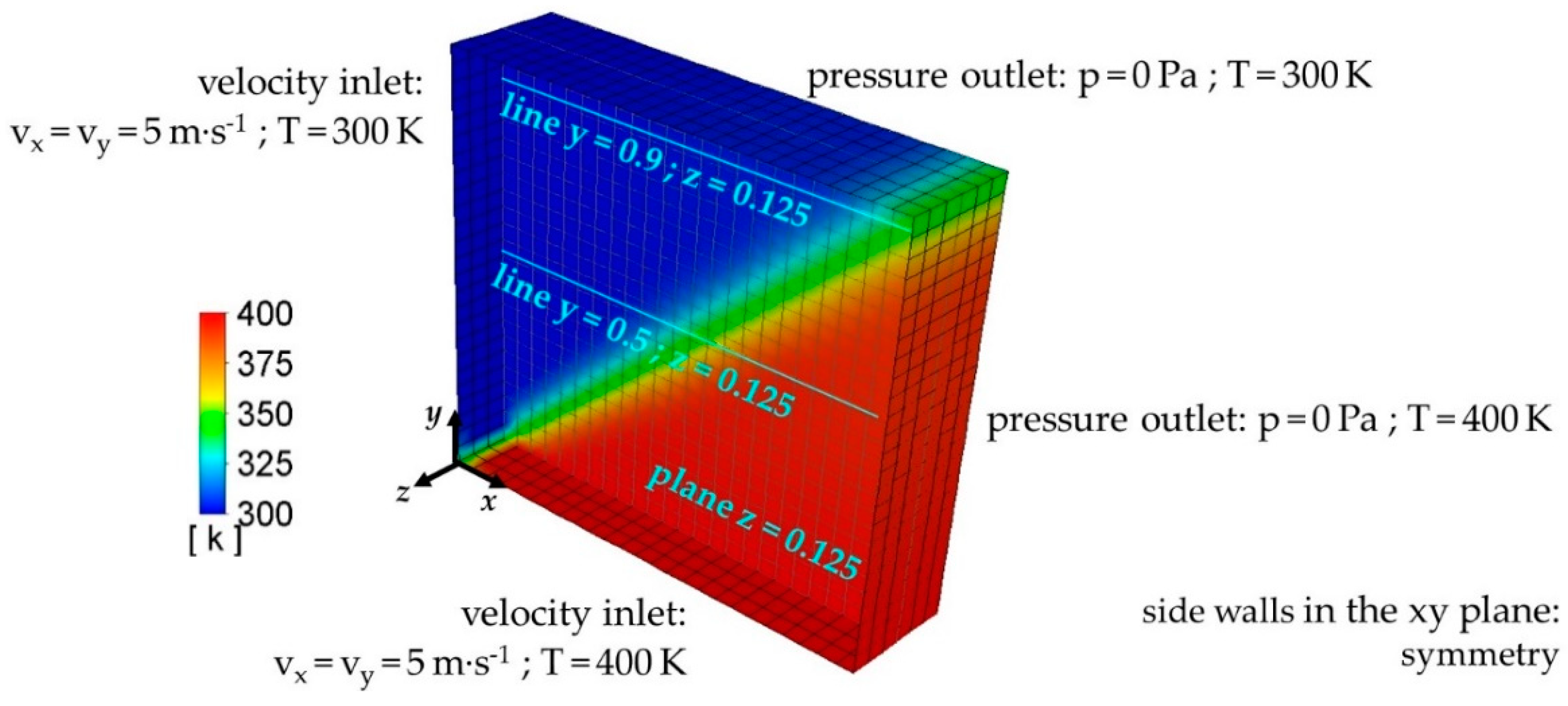
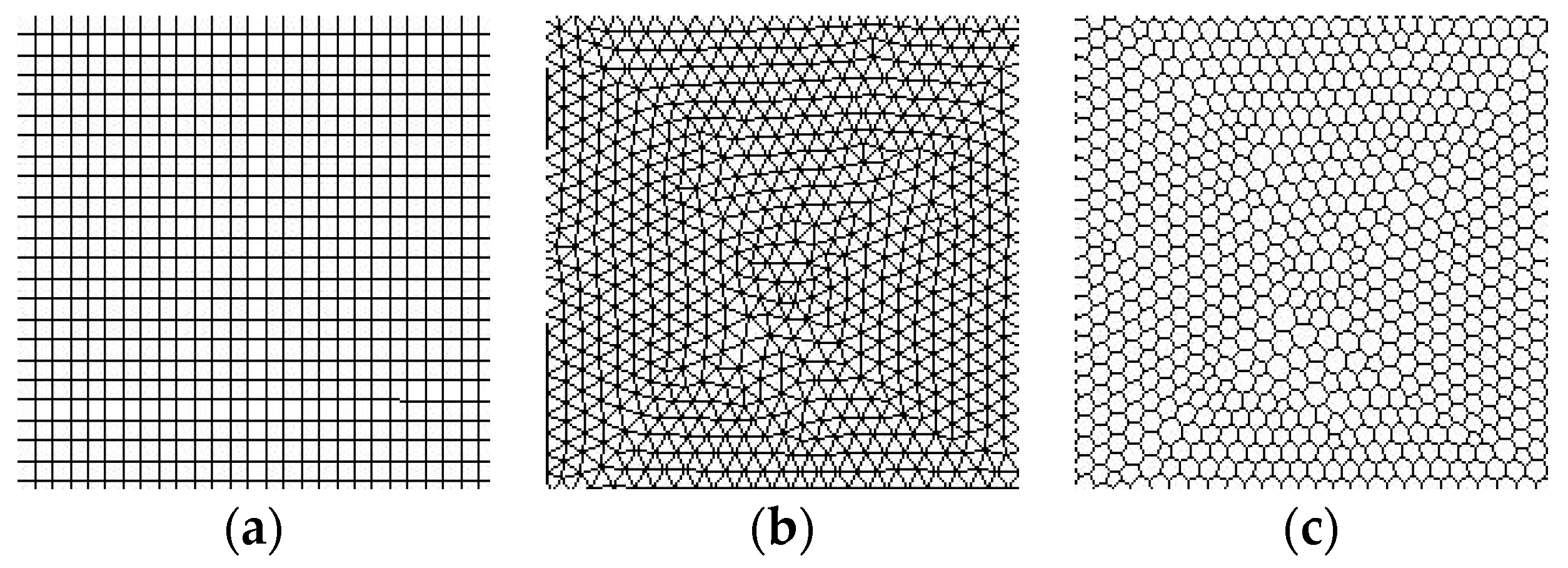




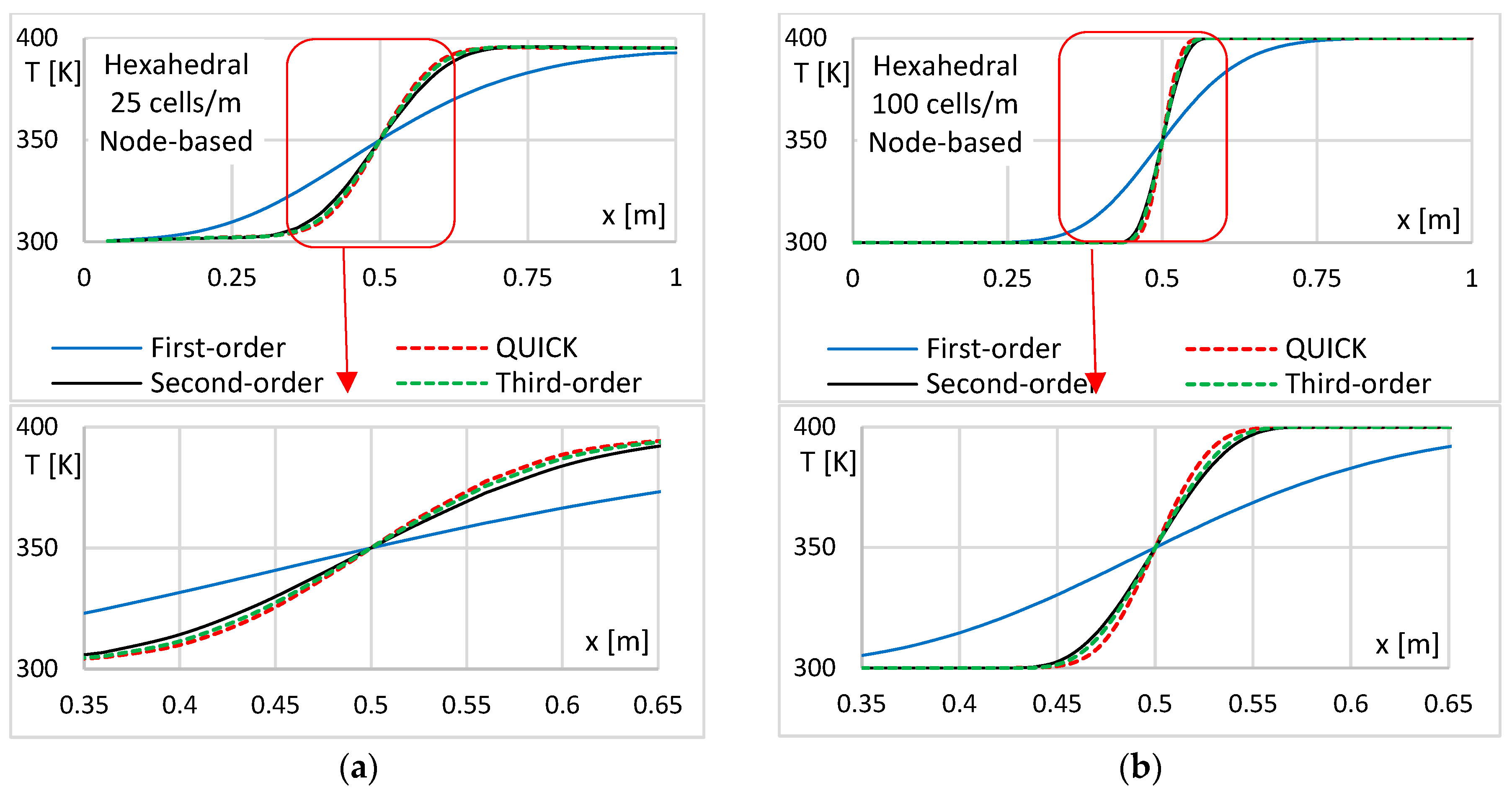

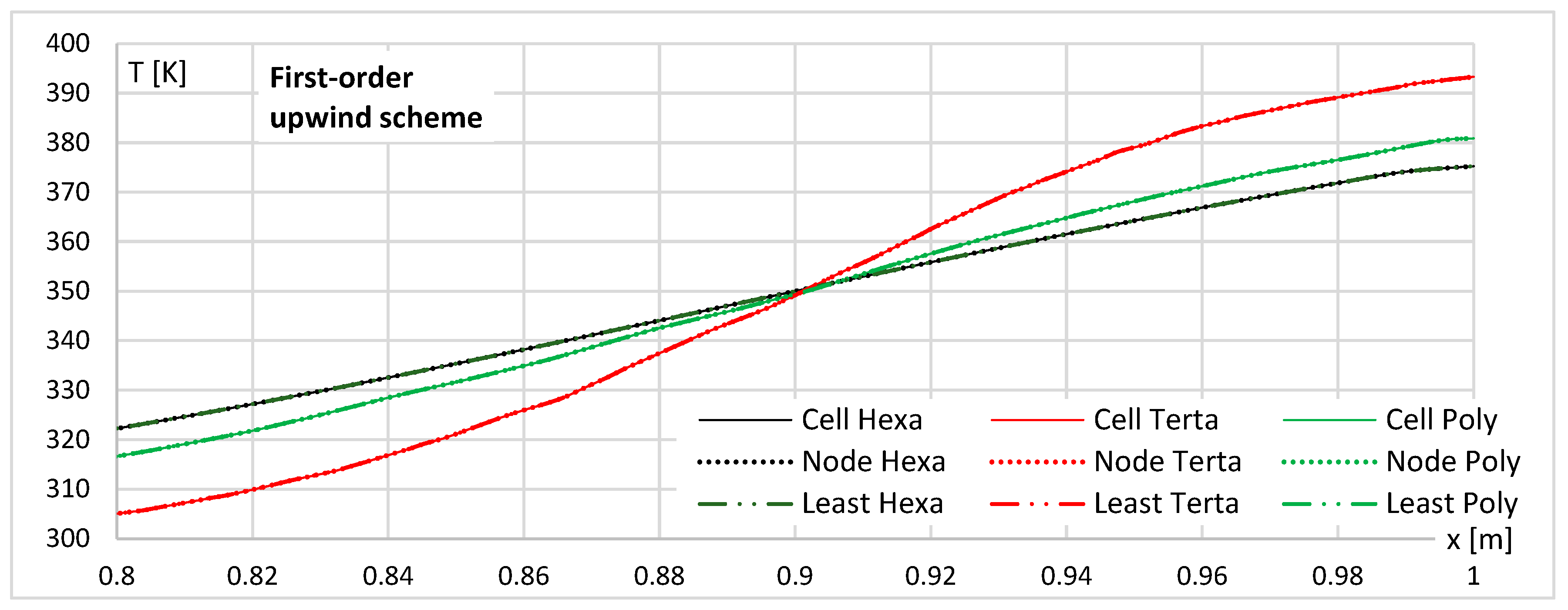


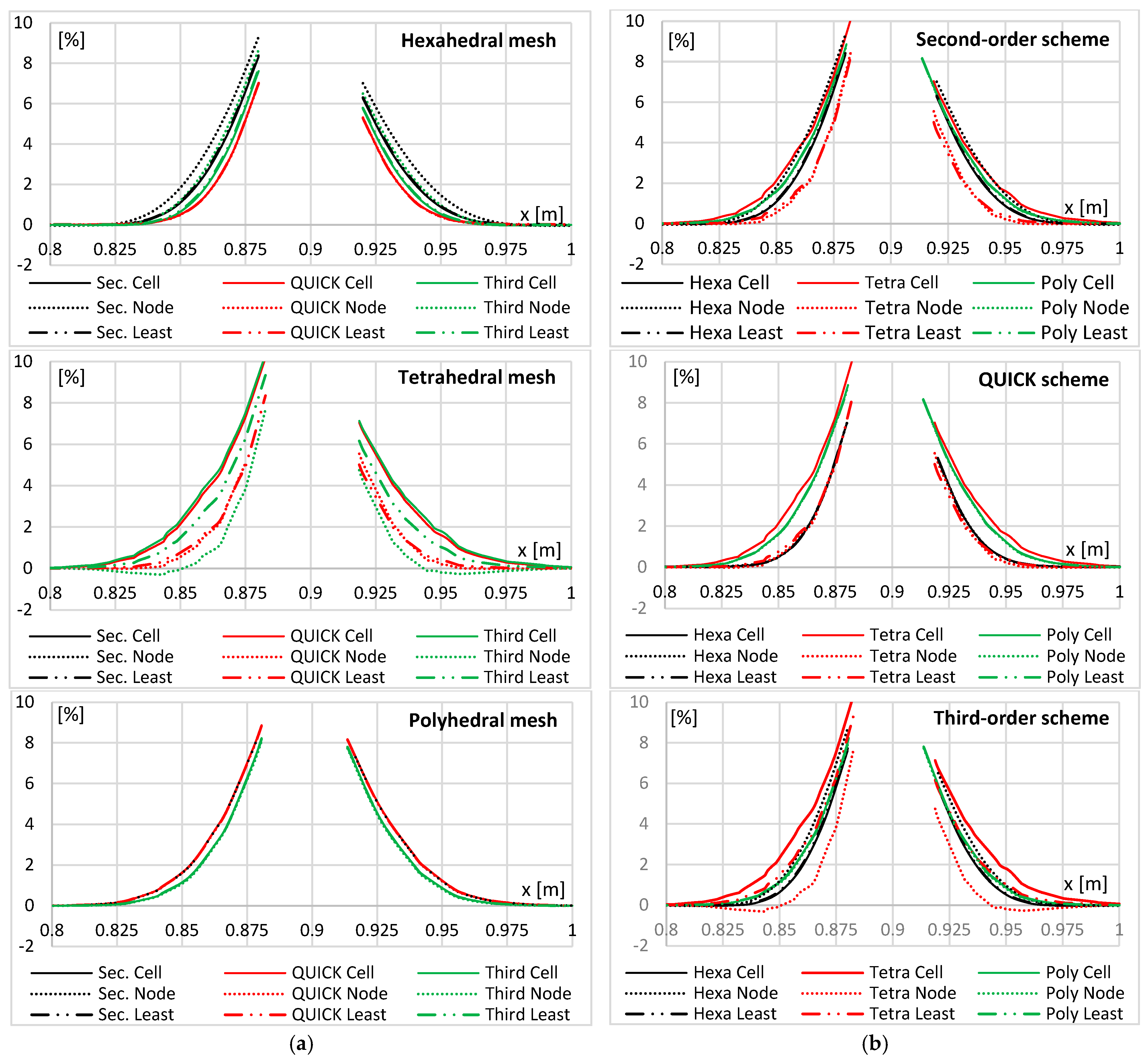
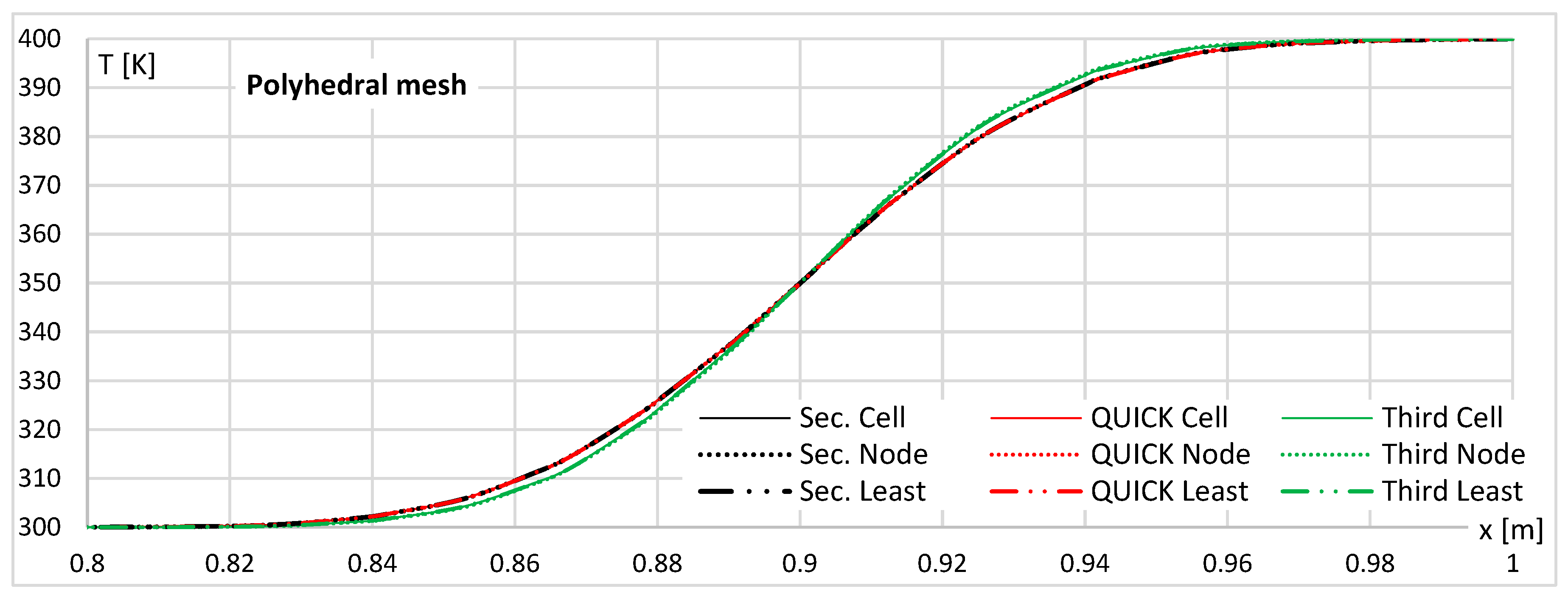
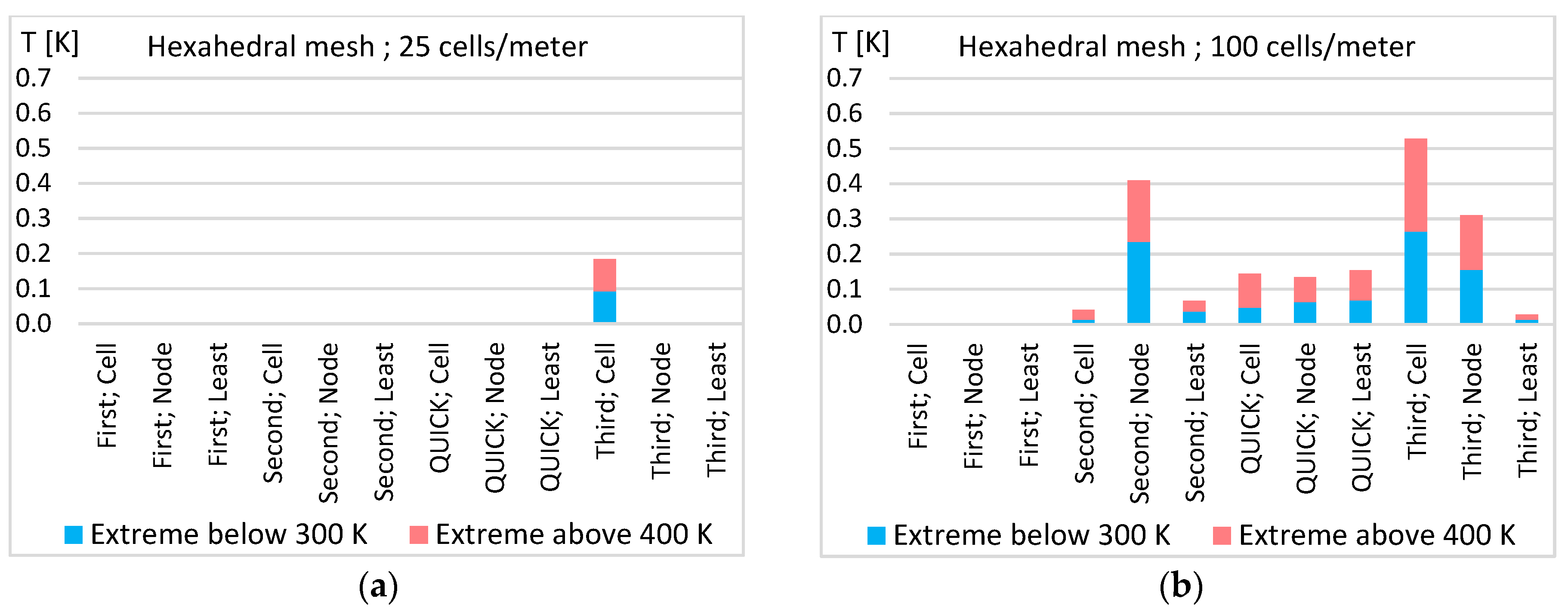

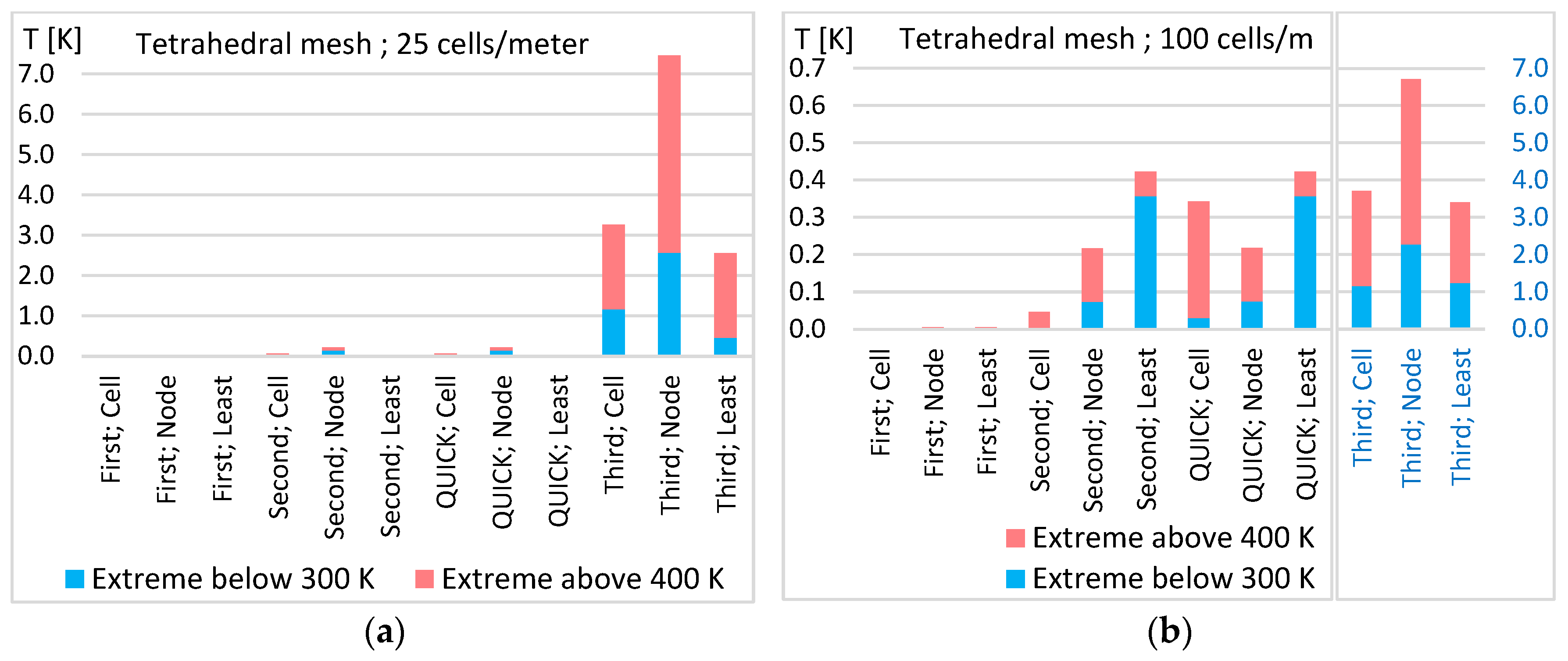
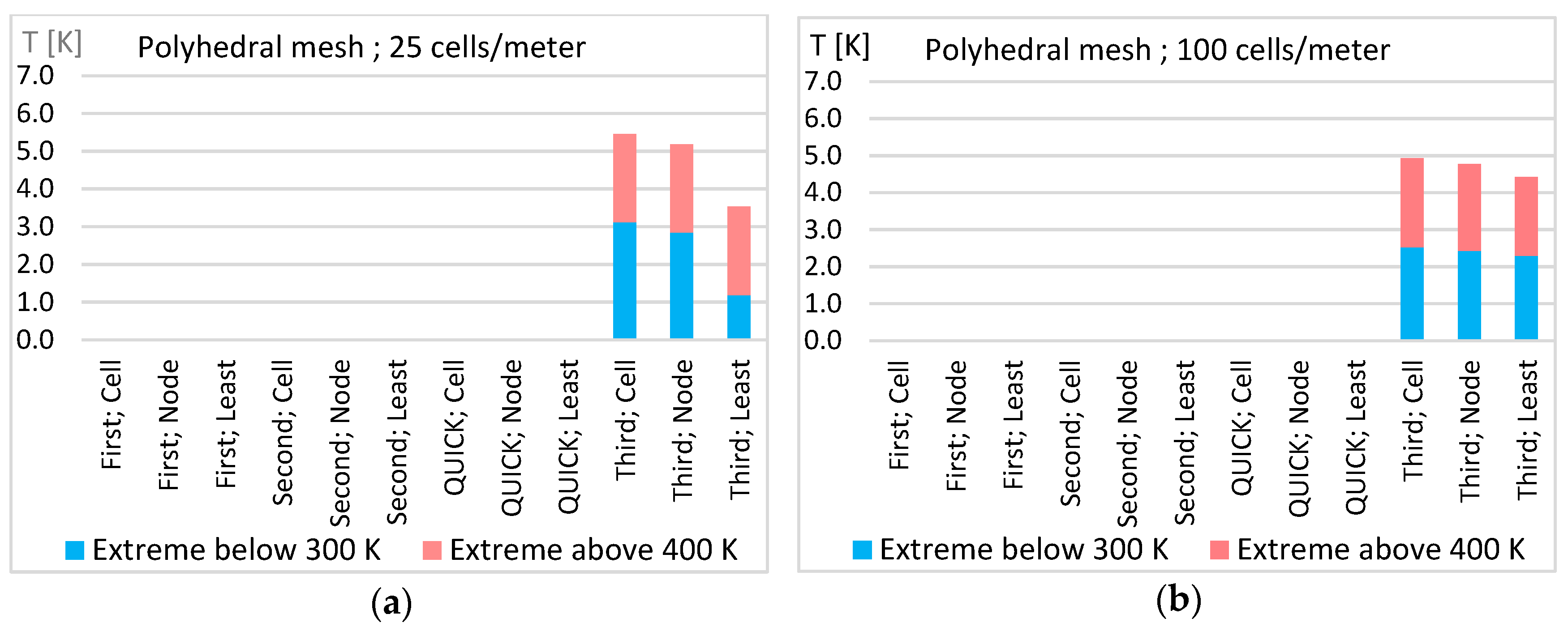
| Mesh Type | Hexahedral | Tetrahedral | Polyhedral | |||
|---|---|---|---|---|---|---|
| Values in Thousands | 25 Cells | 100 Cells | 25 Cells | 100 Cells | 25 Cellstetra | 100 Cellstetra |
| Cells number | 3.8 | 250 | 28.4 | 1660 | 5.9 | 294 |
| Faces number | 12.2 | 765 | 58.9 | 3355 | 38.8 | 2023 |
| Nodes number | 4.7 | 265 | 5.8 | 294 | 32.9 | 1729 |
| Flow Direction → | Description of Discretization Schemes |
|---|---|
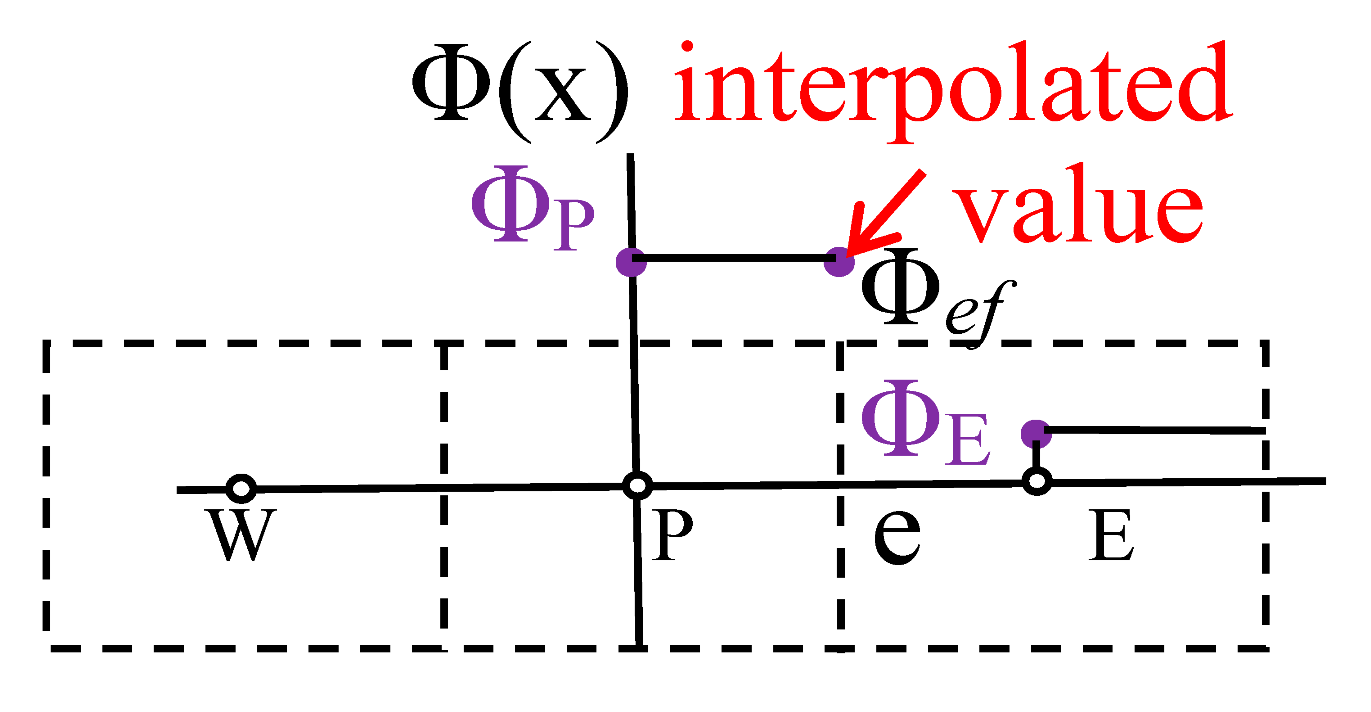 | First-order upwind scheme is based on the assumption that the value of the quantity in the cell center corresponds to the average value in the whole control volume and the face value Φf is set equal to the cell-center value of Φ in the upstream cell. The first-order upwind scheme is not depended on the gradient Φ. |
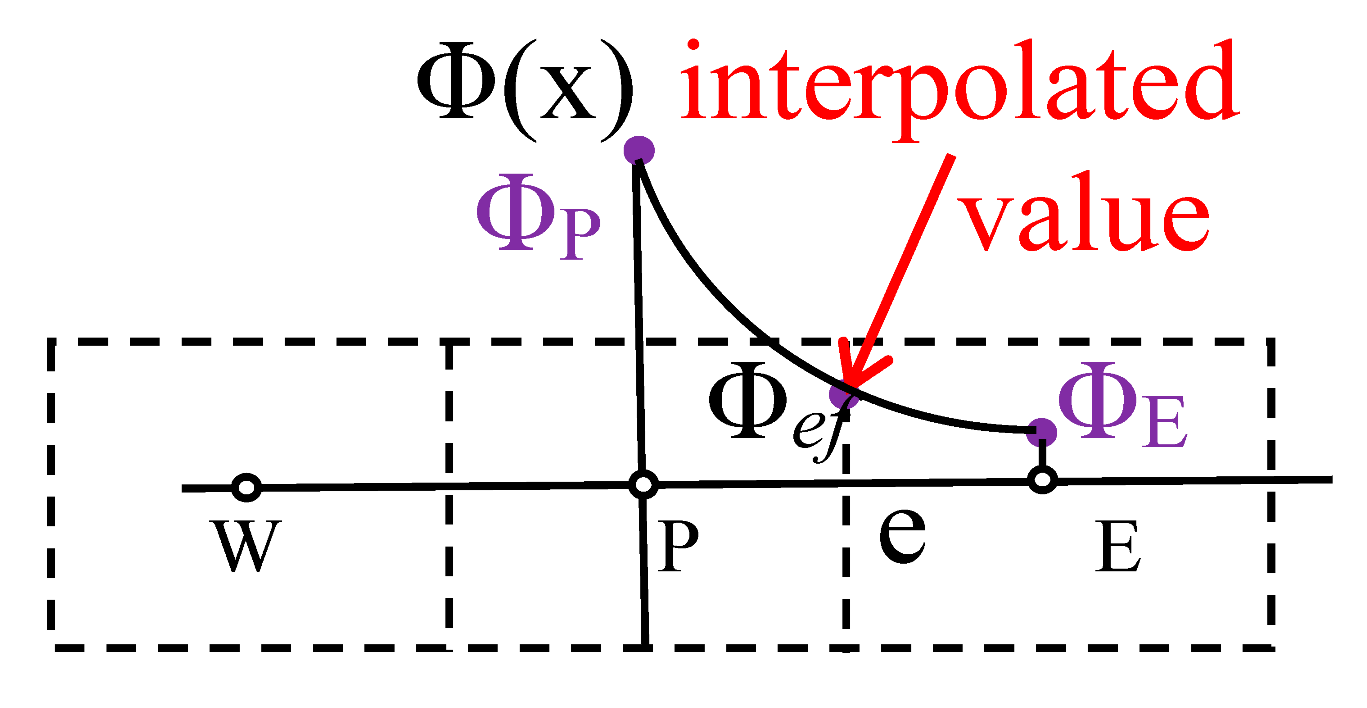 | Power law scheme is based on the analytical solution the one-dimensional advection-diffusion equation. The face value Φf is determined from the exponential profile by using the values of the cell in their center. The exponential profile is depended on the Peclet number Pe (ratio of the convection heat flow (advection) and the heat flow by the mechanism of the convection (diffusion)). The solution is the same with the first-order upwind scheme for |Pe| ≥ 10. |
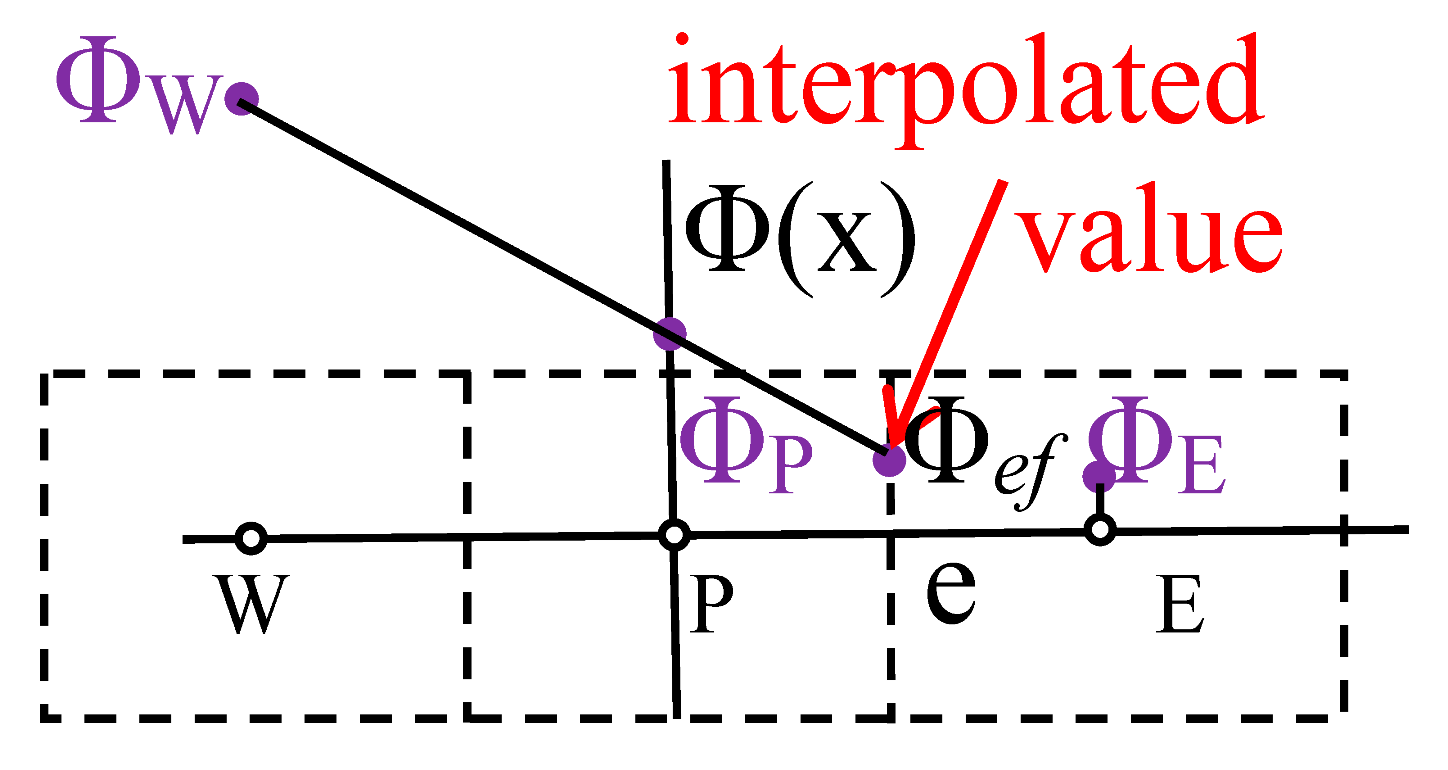 | Second-order upwind scheme: the face value Φf is determined from the cell values in the two cells upstream of the face. This scheme requires the determination of the gradient Φ in each cell. This is more accurate than the first-order upwind scheme, but in the regions with the strong gradients, it can result in the face values that are outside of the range of the correct cell values. |
 | Quadratic Upwind Interpolation for Convective Kinetics (QUICK) scheme. The quadratic curve is fitted with two upstream nodes and one downstream node. This scheme requires the determination of the gradient Φ in each cell. This is a very accurate scheme, but it can lead to stability problems in the calculation in the regions with strong gradients. QUICK scheme, documented in [37], is mainly suitable for the pro structured hexahedral meshes, but it can be used for the unstructured or the hybrid meshes. |
| - | Third-order Monotone Upstream-centered Scheme for Conservation Laws (MUSCL). This third-order convection scheme was created from the original MUSCL [28], by mixing the central differentiation scheme and the second-order winding scheme. This scheme requires the determination of the gradient Φ in each cell. It is usable for all grid types. |
| Mesh Type | Discretization Scheme | Method for Solving Transport Quantity Gradient | Numerical Diffusion | Out Range Values |
|---|---|---|---|---|
| Hexahedral | QUICK scheme | Method does not affect | Lowest of all variants | Significantly low |
| Tetrahedral | Second-order and QUICK schemes | Green–Gauss node-based, or least squares cell-based | Small | Low |
| Polyhedral | Second-order and QUICK schemes | Method does not affect | United | Low |
| Third-order | Method does not affect | Average | High |
| Mesh Type | Discretization Scheme | Explanation |
|---|---|---|
| Hexahedral | Second-order scheme | High diffusion, the largest for Green–Gauss node-based choice, values outside the input range are low, Figure 12, Figure 14, and Figure 16. |
| Third-order scheme | High diffusion for Green–Gauss node-based choice, values outside the input range significantly high, Figure 12, Figure 14, and Figure 16. | |
| Tetrahedral | All schemes | Height diffusion for Green–Gauss cell-based choice, Figure 13 and Figure 14. |
Publisher’s Note: MDPI stays neutral with regard to jurisdictional claims in published maps and institutional affiliations. |
© 2020 by the authors. Licensee MDPI, Basel, Switzerland. This article is an open access article distributed under the terms and conditions of the Creative Commons Attribution (CC BY) license (http://creativecommons.org/licenses/by/4.0/).
Share and Cite
Michalcová, V.; Kotrasová, K. The Numerical Diffusion Effect on the CFD Simulation Accuracy of Velocity and Temperature Field for the Application of Sustainable Architecture Methodology. Sustainability 2020, 12, 10173. https://doi.org/10.3390/su122310173
Michalcová V, Kotrasová K. The Numerical Diffusion Effect on the CFD Simulation Accuracy of Velocity and Temperature Field for the Application of Sustainable Architecture Methodology. Sustainability. 2020; 12(23):10173. https://doi.org/10.3390/su122310173
Chicago/Turabian StyleMichalcová, Vladimíra, and Kamila Kotrasová. 2020. "The Numerical Diffusion Effect on the CFD Simulation Accuracy of Velocity and Temperature Field for the Application of Sustainable Architecture Methodology" Sustainability 12, no. 23: 10173. https://doi.org/10.3390/su122310173
APA StyleMichalcová, V., & Kotrasová, K. (2020). The Numerical Diffusion Effect on the CFD Simulation Accuracy of Velocity and Temperature Field for the Application of Sustainable Architecture Methodology. Sustainability, 12(23), 10173. https://doi.org/10.3390/su122310173






